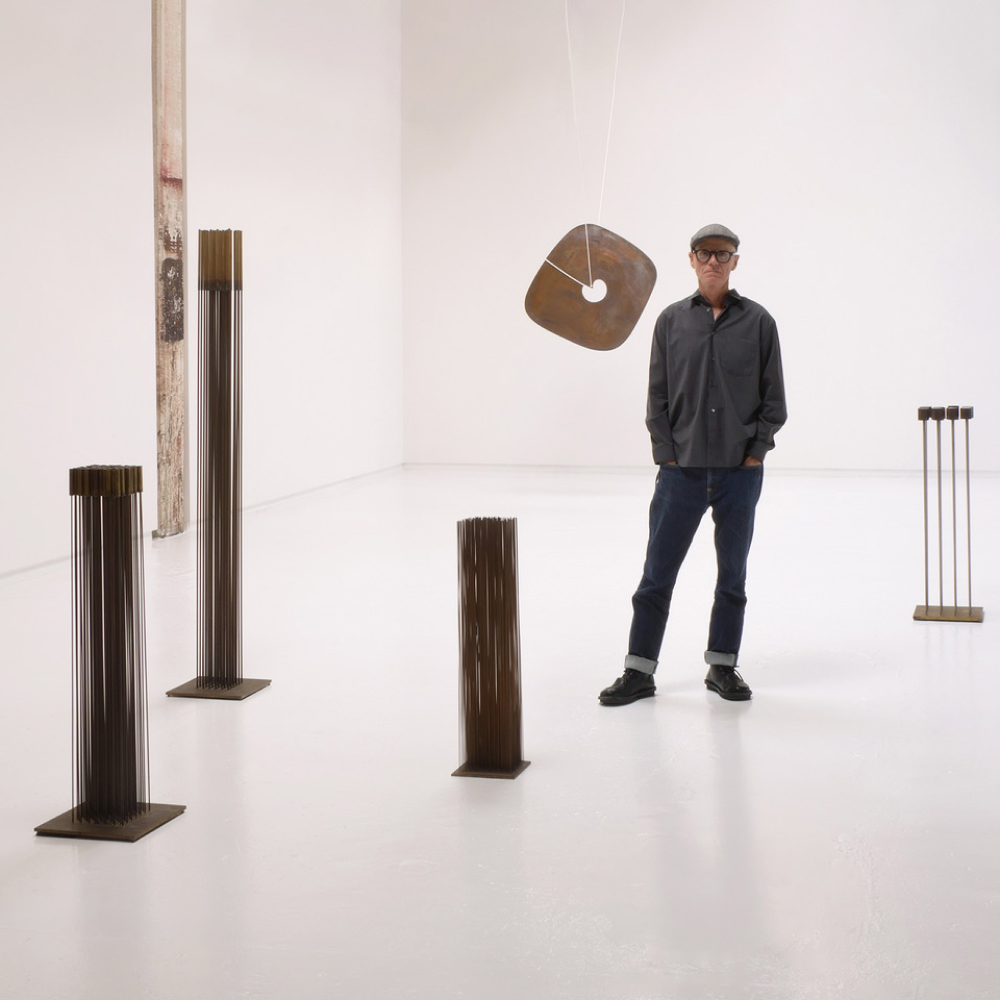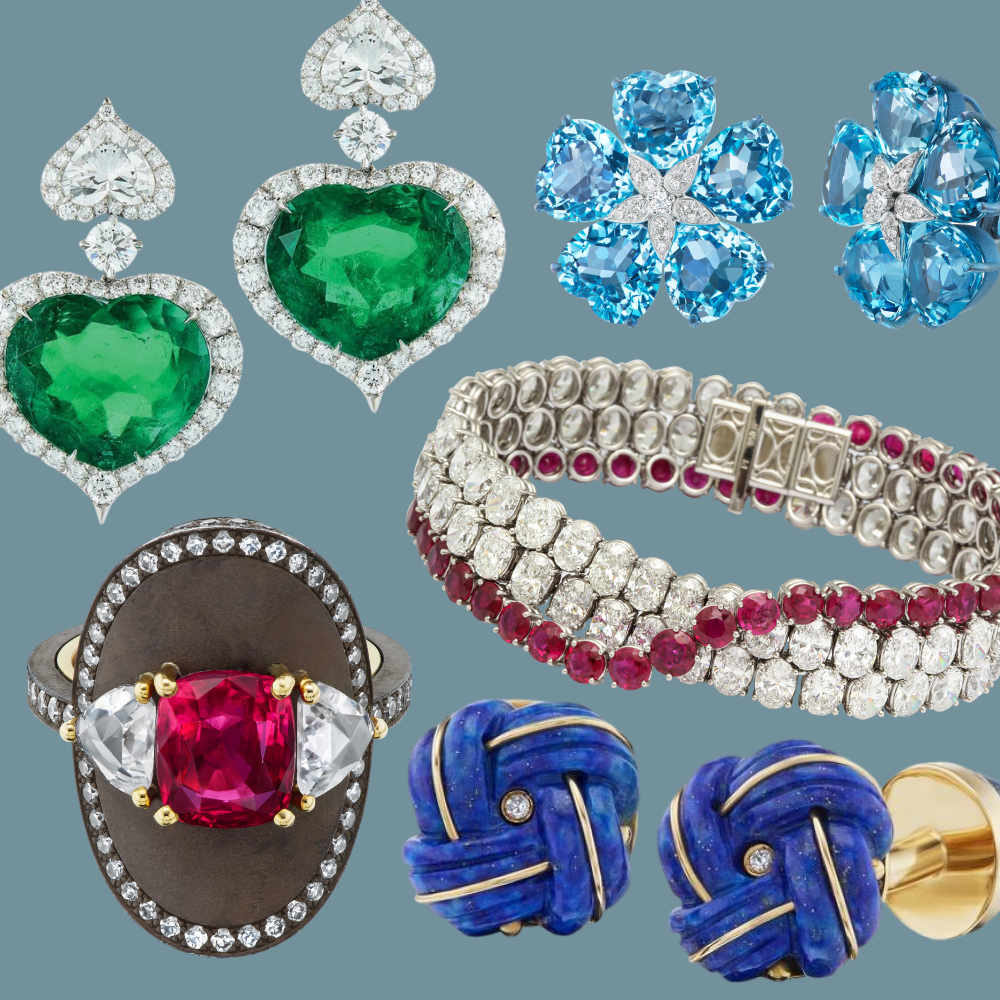September 28, 2025The light inside Hosfelt Gallery feels almost celestial. Northern California rays flood the space from ample skylights and black-casement windows, bouncing off white epoxy floors and 18-foot walls to settle in a gentle glow.
The large building, a former door factory in San Francisco’s Design District, retains traces of its industrial past — exposed rafters, visible pipes, raw edges and architectural quirks — whose character complements the art.
“Art doesn’t live in a vacuum,” says founder Todd Hosfelt. “One of the mistakes people make is turning spaces like this into white cubes. We left the perimeter walls, ceilings and columns as we found them. The gallery is a metaphor for my belief that you can’t understand anything without context.”
It helps that he’s a self-professed “architecture and design junkie” and his husband, Louis Schump, is a principal and creative director of the commercial-architecture mega firm Gensler.
Hosfelt Gallery opened in 1996 in a 2,000-square-foot space (which it quickly outgrew) within the same building as the alternative venue Capp Street Project. Its emphasis was on contemporary artists who push intellectual and material boundaries.
“From the beginning, I showed a pretty even mix of local, national and international artists,” Hosfelt says. “In the case of the nonlocal ones, they’d had little or no exposure in the Bay Area.”
That has changed over the years, partly because many of the artists the gallery championed early on, like Shahzia Sikander, Shirin Neshat, Y.Z. Kami, Alfredo Jaar, Stefan Kürten and Jim Campbell, have since gained global recognition, including locally.

Hosfelt’s own path to the art world was a meandering one. Born in Des Moines, Iowa, in 1963 to an insurance executive father and a mother who taught hearing-impaired kids, he studied English, history and political science at Iowa State University before earning a law degree at the University of Iowa.
But art was always in the background: museum visits with his parents, art-history books gifted by his grandmother and an innate attraction to visual culture. “I don’t remember ever not being interested in art,” he says.
In 1988, Hosfelt moved to Monterey, California, where he briefly practiced law before transitioning to the art world. He held jobs at Ansel Adams’s now-defunct Friends of Photography nonprofit and at Haines Gallery before taking the entrepreneurial leap of launching his own space.
Today, in addition to representing well-known living artists, the gallery oversees the estates of Harry Bertoia, Bruce Conner, Jess (Collins), John O’Reilly, Alan Rath and William T. Wiley.
“As my program matured, the artists I added tended to be more established,” Hosfelt explains. “But I still get excited when I occasionally find an emerging artist I can bring into the program and introduce to our audience.”
That sense of discovery — or, in this case, rediscovery — is on full display in Hosfelt Gallery’s current Bertoia survey, “In the Great Oneness: Drawings, Sculpture & Sound” (on view through October 11). While presenting the Italian-American modernist’s celebrated Sonambient and bronze sculptures, “In the Great Oneness” places fresh emphasis on his drawings, an aspect of his practice that Hosfelt describes as “extraordinarily important to him, but completely under-recognized.”
It’s the kind of show the gallery excels at: context-rich, thoughtfully installed and full of moments that invite deep looking — and listening. Here, Hosfelt tells Introspective more about the Bertoia exhibition and his own adventures in Bay Area art.

What drew you to display Harry Bertoia’s work now — and in this particular way?
I saw a massive Harry Bertoia “Dandelion” sculpture when I was nine. I remember it clearly. I think it impressed me because it was both representational and, at the same time, more than that, though more what I couldn’t have said. The piece could also have been the sun or an explosion, or something nonphysical.
It was both macro- and microscopic. I think it was my introduction to the power of ambiguity in art. So, I’ve been a fan of Bertoia most of my conscious life. When I had an opportunity to connect with Harry’s daughters and show his work, I jumped on it.
It’s been seventy years since the last major solo exhibition of Bertoia’s work on the West Coast. This show needed to be a survey, and I was fortunate to have access to so many types of work of such high quality and with impeccable provenance.
Could you walk us through it?
My gallery space was designed so that you never see the entire show at the same time. There are very controlled views between the spaces, but each time you enter a different gallery, you’re offered a different perspective. I laid the show out semichronologically, so as you move through it, you see themes and variations and, I hope, have insights into Bertoia’s thinking and vision.
You don’t get to the work that’s possibly his best known — the “Tonals,” or “Sonambients” — until you’ve seen the whole of his work. With this show, I’m definitely telling a story about a developing vision. There are a lot of surprises here.

Bertoia straddled sculpture, furniture and sound. How do you see his work resonating with today’s audiences or collectors?
With technology so prominent in our lives, the hand-made and beautifully crafted object is more compelling than ever.
One of the things that Bertoia did was make sculpture for you to touch, handle and use to make music. It’s so sensuous!
Visually, Bertoia epitomizes mid-century modernism. The ideas of the Bauhaus, refined through a postwar-American, optimistic lens. You see so many art historical references, but you have an artist with an original voice.

What’s the connective tissue between the artists you represent, whether emerging, mid-career or established?
There’s a knowledge of history — art, social, political, literary — combined with the vision to make something idiosyncratic and new.
So, I would say it’s both smart and visionary. And there’s a level of skill in execution that’s beyond normal.
How would you describe San Francisco’s art ecosystem?
The Bay Area has had an incredibly rich and diverse art scene since the nineteen forties. Truly original artists like Bruce Conner, Jess, Ruth Asawa, Jay DeFeo, William T. Wiley, Wayne Thiebaud, Richard Diebenkorn and Joan Brown; influential art schools like the San Francisco Art Institute, California College of the Arts, UC Davis; respected museums; smart, dedicated gallerists; an abundance of nonprofit alternative venues; a great collector base — everything a healthy art ecosystem needs.

And how do you see that in conversation with New York, Los Angeles or global art markets?
San Francisco has always been its own thing. Postwar and through the nineties, I’d say that most artists on the West Coast didn’t expect to make a living selling their art. So, to a great degree, they made work outside market pressures. It resulted in some wonderful, crazy stuff.
Now, of course, everyone everywhere has access to the same images and the same art from anyplace in the world. It’s homogenized art making, and that’s a shame.
The Bay Area has about eight million people. The New York and L.A. metro areas each have about twenty million. We’re a small town, relatively. But it’s a wealthy, well-educated area with a broad collecting base.
And although the tech industry has been notoriously weak in its support of the arts, it’s raised the fortunes of everyone in the area, and that’s been good for the arts here.
Are you seeing any shifts in what collectors are responding to lately?
The speculative art-buying market has cooled, thankfully. The people buying at the moment are people who are in it because they love art.

What do you do outside of running the gallery?
I am a reader, runner, yoga practitioner, gardener and cook. Now, I also have an organic walnut orchard north of San Francisco.
What work do you regret having sold?
I sold an Ed Ruscha painting off my living room wall that I still miss twenty years later.
What would be your dream exhibition to hang at Hosfelt Gallery?
A show of Calder mobiles would look really fantastic in my space.



